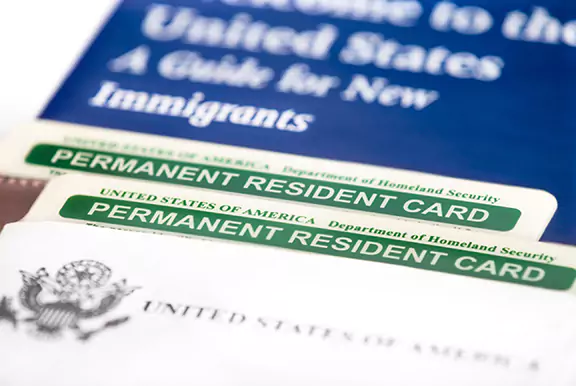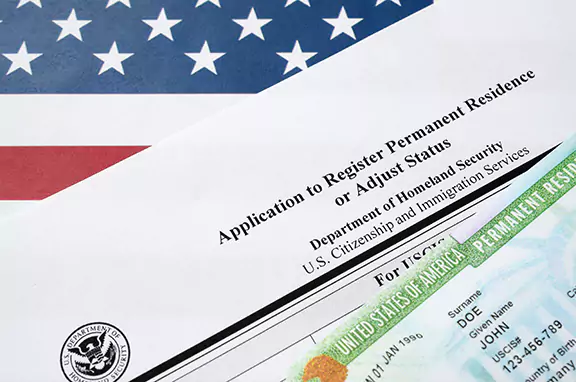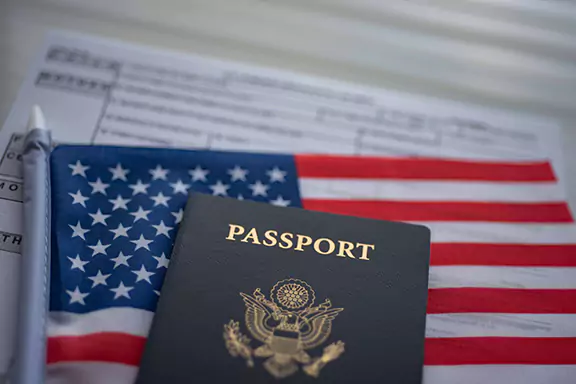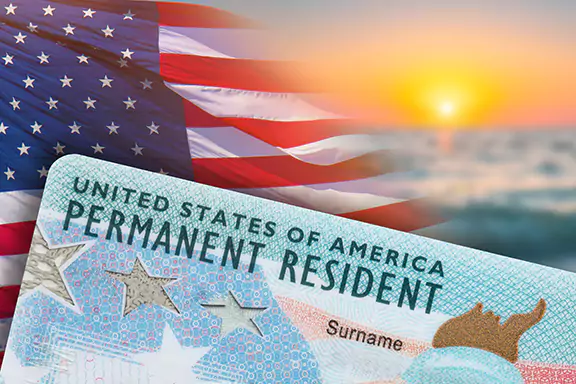Are you thinking about moving to the United States? If so, you might have heard about a U.S. Green Card. But what is a US Green Card, and why is it so important? Understanding this key identification document is essential for anyone looking to live and work in the U.S. on a permanent basis.
Below we’ll cover everything you need to know about what a U.S. Green Card is, how it works, and the benefits it provides.
What Is a U.S. Green Card?
A U.S. Green Card, officially known as a Permanent Resident Card, grants you the status of a lawful permanent resident (LPR). This means you have been authorized to live and work permanently in the United States. As a Green Card holder, you have many of the same rights as U.S. citizens, including the ability to work in any job you are qualified for and the freedom to travel in and out of the country.
Being a Green Card holder comes with several benefits. For starters, you can live in the U.S. on a permanent basis, apply for U.S. citizenship after a certain period, as well as sponsor certain family members to join you in your new home. Additionally, having a Green Card means you are protected by all the laws of the United States, your state of residence, and local jurisdictions.
There are different ways to obtain a Green Card. You can be sponsored by a family member or a U.S. employer, or you could qualify through the Green Card lottery or as a refugee or asylee. Each pathway has its own specific requirements and processes, but all lead to the same goal: permanent residency in the United States.
Understanding the importance of a Green Card and how it impacts your status in the U.S. is crucial. This card not only allows you to live and work permanently in the United States but also opens up opportunities for you and your family to build a new life in your new home country.

Types of Green Cards
When you apply for a U.S. Green Card, it’s important to understand the different types available and which category fits your situation best. Here’s a breakdown of the main types of Green Cards:
Family-Based Green Cards
Immediate Relatives
If you are an immediate relative of a U.S. citizen, you can apply for a family-based Green Card. Immediate relatives include spouses, unmarried children under 21, and parents of U.S. citizens. This category typically has no waiting list, making the green card process much faster.
Family Preference Categories
through family preference categories. These include adult children, both married and unmarried, as well as siblings of U.S. citizens. Green Card holders can also sponsor their spouses and unmarried minor children. However, these categories often have longer waiting times due to annual limits on visas.
Employment-Based Green Cards
EB-1: Priority Workers
If you have extraordinary ability in the sciences, arts, education, business, or athletics, or if you are an outstanding professor, researcher, or multinational executive, you may qualify for an EB-1 Green Card. This category is for top-tier talent and is highly competitive.
EB-2: Advanced Degrees and Exceptional Abilities
This category is for professionals holding advanced degrees or those with exceptional abilities in their field. If you have a master’s degree or higher, or if you possess exceptional abilities in sciences, arts, or business, you may be eligible for an EB-2 Green Card.
EB-3: Skilled Workers and Professionals
The EB-3 category includes skilled workers with at least two years of experience, professionals with a U.S. bachelor’s degree or its foreign equivalent, and unskilled workers for jobs that require less than two years of training or experience.
EB-4: Special Immigrants
Special immigrant categories include religious workers, employees of U.S. foreign service posts, retired employees of international organizations, and other specific groups. If you belong to any of these special categories, you might qualify for an EB-4 Green Card.
EB-5: Investors
If you are willing to invest a substantial amount of money in a new commercial enterprise in the U.S. that creates at least 10 full-time jobs for U.S. workers, you can apply for an EB-5 Green Card. The required investment amount varies depending on the location and type of investment.
Other Categories
Diversity Visa Lottery
The Diversity Visa Lottery, also known as the Green Card lottery, provides up to 50,000 Green Cards annually to individuals from countries with low rates of immigration to the United States. If you are from an eligible country, you can enter the immigrant visa lottery and, if selected, apply for a Green Card.
Humanitarian Programs
If you are a refugee or asylee, you can apply for a Green Card one year after being granted asylum or refugee status. This category also includes victims of human trafficking, crime, and abuse. Special provisions are available for these humanitarian cases to help protect vulnerable individuals.
Each type of Green Card has its own set of requirements and processes. Understanding the category of permanent resident cards you qualify for will help you take the right steps towards becoming a lawful permanent resident in the United States.
Eligibility and Application Process
The following are what you need to know about the eligibility and application process for a U.S. Green Card:
General Eligibility Requirements
To be eligible for a U.S. Green Card, you must meet specific criteria based on the type of Green Card you are applying for. Common eligibility categories include:
Family Sponsorship: You must have a family member who is a U.S. citizen or Green Card holder who can sponsor you.
Employment Sponsorship: You need a job offer from a U.S. employer willing to sponsor you.
Refugee or Asylee Status: If you have been granted asylum or refugee status, you can apply for a Green Card after one year.
Diversity Visa Lottery: If you are selected through the Diversity Visa Lottery, you can apply for a Green Card within 6 months of being notified.
Each category has specific requirements, so make sure to check the detailed eligibility criteria for your particular situation.
Application Steps
Applying for a U.S. Green Card involves several steps. Here’s a general outline of the process:
Filing a Petition
The first step in the Green Card application process is filing a petition. Depending on your situation, a family member or employer must file the petition on your behalf. If you are applying through the Diversity Visa Lottery or as a refugee/asylee, you may be able to file the petition yourself.
Family-Based Green Cards: Your U.S. citizen or Green Card holder relative files Form I-130 (Petition for Alien Relative).
Employment-Based Green Cards: Your U.S. employer files Form I-140 (Immigrant Petition for Alien Worker).
Approval and Visa Availability
Once the petition is filed, it must be approved by U.S. Citizenship and Immigration Services (USCIS). After approval, you need to wait for a visa number to become available. Visa availability depends on your specific category and nationality.
Immediate Relatives: There are no numerical limits, so visas are usually available immediately.
Family Preference and Employment Categories: These categories have annual limits, which can result in longer waiting times.
Consular Processing vs. Adjustment of Status
After a visa number becomes available, you have two options for completing your Green Card application:
Consular Processing: If you are outside the United States, you will apply for your Green Card through the U.S. embassy or consulate in your home country. You will need to attend an interview and provide various documents, including your visa approval notice and medical examination results.
Adjustment of Status: If you are already in the United States on a valid visa, you can apply for a Green Card without leaving the country. You will file Form I-485 (Application to Register Permanent Residence or Adjust Status) with USCIS. This process includes a biometrics appointment and an interview.
Additional Tips
Stay Informed: Regularly check the USCIS website and the Visa Bulletin to stay updated on visa availability and any changes to the application process.
Seek Legal Help: Consider hiring an immigration lawyer, especially if your case is complex or if you need help understanding the requirements.
Keep Documentation Organized: Maintain copies of all forms, correspondence, and supporting documents to ensure you have everything you need for your application and any follow-up steps.
By understanding the eligibility requirements and following the correct application steps, you can increase your chances of successfully obtaining a U.S. Green Card and achieving a permanent residence status in the United States.

Maintaining Green Card Status
Once you obtain your U.S. Green Card, it’s important to understand how to maintain your permanent resident status. Here’s what you need to know to remain a lawful permanent resident in the United States.
Rights and Responsibilities
As a Green Card holder, you have several rights and responsibilities:
Rights
Live Permanently in the U.S.: You have the right to live anywhere in the United States.
Work Permanently: You can work in any job you are qualified for, except for certain jobs that are restricted to U.S. citizens for security reasons.
Protection Under the Law: You are protected by all U.S. laws, including federal, state, and local regulations.
Responsibilities
Obey the Law: You must obey all U.S. laws, including federal, state, and local laws.
File Income Tax Returns: You are required to file U.S. federal and state income tax returns and report your income to the Internal Revenue Service (IRS) and state tax authorities.
Register with the Selective Service: If you are a male between the ages of 18 and 25, you must register with the Selective Service System.
Renewal and Replacement
Your Green Card is valid for either three or ten years (depending on your status). To keep your status as a permanent resident, you must renew your Green Card before it expires. Here’s how to do it:
Renewal: File Form I-90 (Application to Replace Permanent Resident Card) with USCIS six months before your Green Card’s expiration date. This ensures you receive your new card before the old one expires.
Replacement: If your Green Card is lost, stolen, or damaged, you need to replace it by filing Form I-90. This form is also used if your card contains incorrect information or if you legally change your name.
Physical Presence Requirement
To maintain your Green Card status, you must physically reside in the United States. Spending extended periods outside the U.S. can jeopardize your status. Here are some guidelines:
Short Trips: You can travel outside the U.S. for short trips, but make sure you return within six months.
Longer Absences: If you plan to be outside the U.S. for more than six months but less than a year, you should carry evidence of your ties to the U.S., such as a job, family, or property.
Re-entry Permit: For absences longer than one year, you must obtain a re-entry permit before leaving the U.S. This permit allows you to return and maintain your permanent resident status.
Traveling with a Green Card
As a Green Card holder, you can travel freely outside the United States, but there are a few things to keep in mind:
Travel Documents: Always carry your Green Card and a valid passport from your home country when traveling.
Re-entry to the U.S.: Upon returning to the U.S., present your Green Card and passport to the immigration officer at the port of entry. They will verify your status and allow you to re-enter the country.
Path to U.S. Citizenship

By understanding and adhering to these guidelines, you can effectively maintain your Green Card status and continue to enjoy the benefits of being a lawful permanent resident in the United States.
Maintaining your Green Card status is also crucial if you plan to apply for U.S. citizenship. After holding your Green Card or permanent residency for a certain period (typically five years, or three years if married to a U.S. citizen), you may be eligible to apply for naturalization. During this time, you must demonstrate continuous residence, good moral character, and knowledge of English and U.S. civics.
Naturalization Eligibility
As a Green Card holder, you can apply for U.S. citizenship through a process called naturalization. To be eligible, you must meet certain criteria:
Residency Requirements: You must have been a lawful permanent resident for at least five years. If you are married to a U.S. citizen, this period is reduced to three years.
Continuous Residence: You must have continuously lived in the United States for at least five years (or three years if married to a U.S. citizen) without long absences.
Physical Presence: You must have been physically present in the U.S. for at least 30 months out of the five years (or 18 months out of three years if married to a U.S. citizen).
Good Moral Character: You must demonstrate good moral character, meaning you have obeyed U.S. laws and not committed serious crimes.
English and Civics Knowledge: You must be able to read, write, and speak basic English and have a knowledge of U.S. history and government.
Steps to Apply for United States Citizenship
Once you determine that you are eligible, follow these steps to apply for U.S. citizenship:
File Form N-400
The first step is to file Form N-400, Application for Naturalization, with U.S. Citizenship and Immigration Services (USCIS). This form requires detailed information about your background, residence, and employment history. You will also need to pay the application fee.
Attend a Biometrics Appointment
After submitting your application, USCIS will schedule a biometrics appointment. During this appointment, your fingerprints, a photograph, and a signature will be taken for background checks.
Complete the Interview and Tests
Once your background checks are complete, USCIS will schedule an interview. During the interview, a USCIS officer will review your application and ask questions about your background and your knowledge of English and U.S. civics. You will take two tests:
English Test: This test assesses your ability to read, write, and speak basic English.
Civics Test: This test evaluates your knowledge of U.S. history and government.
Receive a Decision
After your interview and tests, USCIS will make a decision on your application. If approved, you will receive a notice to take the Oath of Allegiance.
Take the Oath of Allegiance
The final step in the naturalization process is taking the Oath of Allegiance at a naturalization ceremony. By taking this oath, you swear loyalty to the United States and agree to uphold its laws and Constitution. After the ceremony, you will receive your Certificate of Naturalization, officially making you a U.S. citizen.
By following these steps and meeting the requirements, you can achieve U.S. citizenship and enjoy the full rights and privileges that come with it, including the right to vote, travel with a U.S. passport, and sponsor certain family members for Green Cards. Becoming a U.S. citizen is a rewarding accomplishment that opens many doors and opportunities for you and your family.
Challenges and Tips for Green Card Applicants
Applying for a U.S. Green Card can be a complex and time-consuming process. Here are some common challenges you might face and tips to help you overcome them.
Common Challenges
Application Delays One of the most common challenges for Green Card applicants is experiencing delays in the application process. These delays can occur due to various reasons, such as backlogs at U.S. Citizenship and Immigration Services (USCIS), incomplete applications, or additional background checks.
Visa Bulletin Changes The availability of visas can change monthly based on the U.S. Department of State’s Visa Bulletin. This means that even after your petition is approved, you may need to wait for your visa number to become available, especially if you are applying under family preference or employment categories.
Complex Documentation Gathering and submitting the required documentation can be daunting. You need to provide accurate and complete information to avoid any delays or rejections. This includes proof of your relationship to a U.S. citizen or Green Card holder, employment verification, and other personal documents.
Tips for a Smooth Application Process
Stay Informed Regularly check the USCIS website and the Visa Bulletin for updates on visa availability and any changes to the application process. Staying informed will help you understand where you are in the process and what to expect next.
Seek Legal Help Consider hiring an immigration lawyer, especially if your case is complex or if you are unsure about the requirements. A lawyer can provide valuable guidance, help you avoid common pitfalls, and ensure that your application is complete and accurate.
Be Thorough and Accurate When filling out forms and gathering documents, make sure all information is accurate and complete. Double-check everything before submitting your application. Inaccurate or incomplete information can lead to delays or even denials.
Keep Copies of Documents Maintain copies of all forms, correspondence, and supporting documents. Having a complete record of your application materials can be helpful if you need to reference them later or if any issues arise.
Respond Promptly If USCIS requests additional information or documents, respond promptly. Delays in responding can extend the processing time of your application. Make sure you understand what is being requested and provide the necessary information as quickly as possible. ***Regularly check your status on the USCIS website. Physically mailed notifications or requests for more information may arrive after the cutoff date. All notifications can be found in your online USCIS account.
Prepare for the Interview If you are required to attend an interview, prepare thoroughly. Review your application and be ready to answer questions about your background, employment, and intentions in the United States. Being well-prepared can make a positive impression and help your application process go smoothly.
By understanding these challenges and following these tips, you can improve your chances of successfully obtaining a U.S. Green Card. While the process may be complex, staying informed about immigration law, seeking help when needed, and being diligent with your application can help you achieve your goal of becoming a lawful permanent resident in the United States.
Apply for Your Green Card Today
Getting a U.S. Green Card is a significant step towards living and working in the United States. By understanding the types of Green Cards, the application process, and how to maintain your status, you can navigate this journey more confidently. If you need more information or assistance, don’t hesitate to seek help from trusted sources or professionals.

